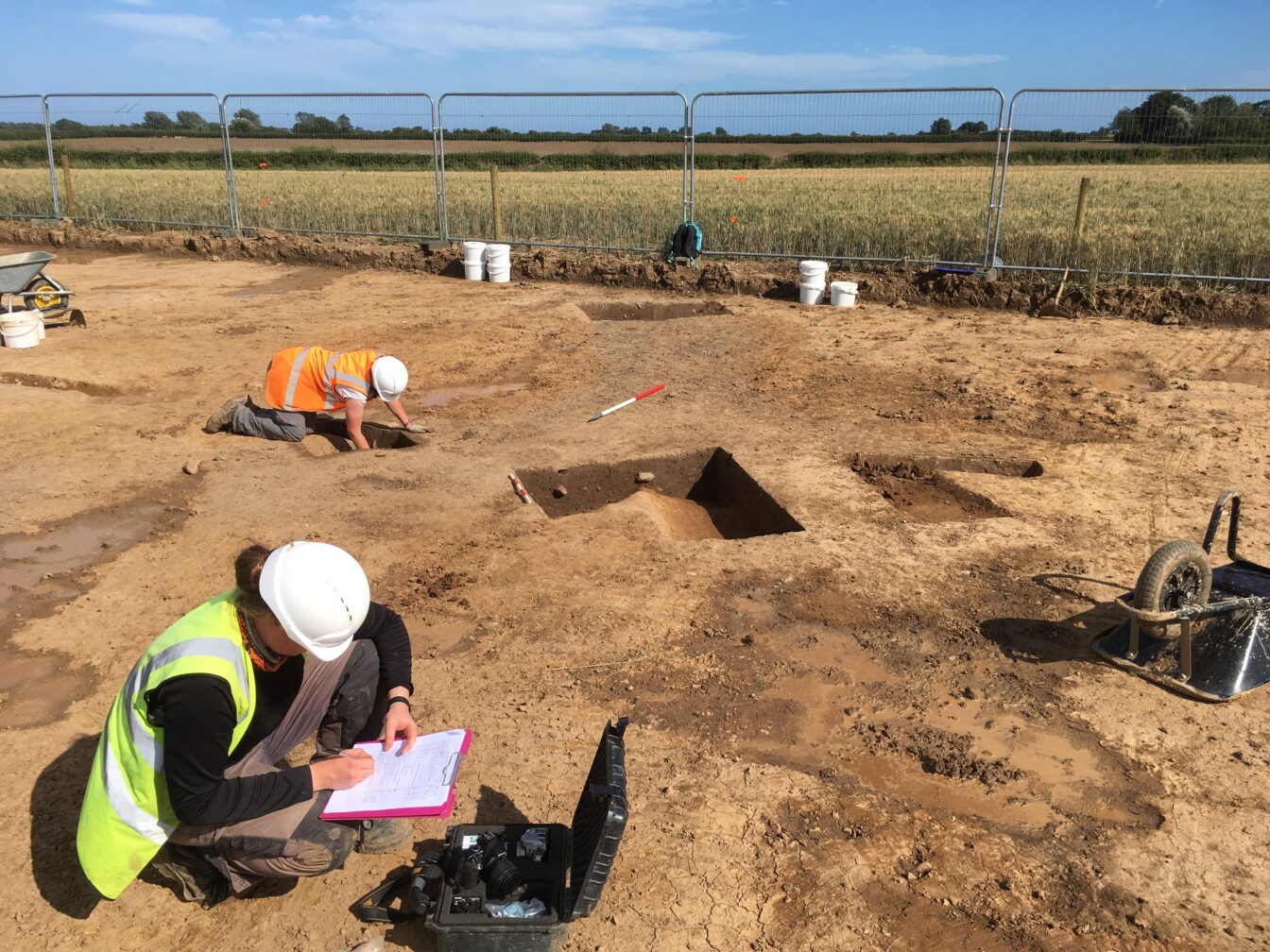World’s largest offshore windfarm unearths evidence of early Anglo-Saxon activity in Holderness

- Anglo-Saxon discoveries near Ulrome and Skipsea close to location where Anglo-Saxon timber hall was excavated by York University earlier this year.
- Dogger Bank discoveries indicate Anglo-Saxons settled in Holderness.
- Evidence of Bronze Age, Iron-Age and Roman presence also excavated during Dogger Bank work.
- Archaeologists to talk about their significant discoveries at public event in Ulrome on 20 September.
Archaeologists working on Dogger Bank Wind Farm will reveal at a public event next week how they unearthed significant evidence of Anglo-Saxon presence in Holderness.
The ground-breaking early medieval discoveries were unearthed by the archaeologists working on the 30km corridor that houses the underground cables transmitting renewable energy from Dogger Bank Wind Farm in the North Sea, to the wind farm’s two onshore convertor stations off the A1079 near Beverley.
These significant discoveries include remnants of an Anglo-Saxon long hall structure between Beeford and Skipsea, and an Iron-Age or Anglo-Saxon glass bead recovered from a site in Ulrome. The two sites close to Beeford produced the most evidence for Anglo-Saxon activity.
More radiocarbon dating of the activity on these sites is required, but at the moment an area of 5th-6th century activity associated with metalworking has been identified, close to a separate area where a long hall and field system ditches were recorded. The findings indicate Anglo-Saxons probably lived and farmed in this landscape over multiple phases between the 5th-11th centuries.
Radiocarbon dating is a scientific method for accurately determining the age of organic materials, by analysing the decay of radioactive isotopes. The developers of the windfarm have invested in this technique to ensure the project provides local communities and historians with accurate data about how the land was used hundreds of years ago.
Across the pipeline route archaeologists also discovered Iron Age and Roman evidence including well-preserved roundhouses in Ulrome, Beeford and Leven, a long-handled bone comb in Leven and significant amounts of handmade and wheel-thrown pottery.
It has long been clear the Holderness area was inhabited by the Anglo-Saxons due to the names of the towns and villages in the area, many of which incorporate Anglo-Saxon elements. Over recent years archaeological evidence has begun to emerge of Anglo-Saxon activity in the landscape, and the findings near Beeford add significantly to an emerging picture of Anglo-Saxon life in the region, greatly enhancing understanding of the period in Holderness.
The evidence for domestic and industrial activity that was unearthed at the sites, which has been evaluated and confirmed by medieval specialists, is of particular importance and significance.
Since the excavations at Beeford, a team of experts from York University has excavated a nearby site in Skipsea, further confirming the presence of Anglo-Saxons in the local area, centuries ago.
Community Engagement Manager for Dogger Bank Wind Farm, Rachel Lawrence, said:
“Safeguarding historical evidence has been a critical part of our preparation work on Dogger Bank Wind Farm. We’re delighted we’re now able to share these exciting findings with the people who live in the towns and villages where this work was undertaken.
“As well as the multi-million pound investment Dogger Bank Wind Farm is making to support its key coastal communities, this work will add to the legacy we’ve created during the construction of the world’s largest offshore wind farm.”
The work was completed by Dogger Bank Wind Farm contractor AOC Archaeology, and their analysis has been supported by a wide team of artefact and period specialists.
Dogger Bank Wind Farm has commissioned the production of replicas of some of the artefacts for educational purposes, and is set to share these with the public for the first time next week.
Representatives from the wind farm and AOC Archaeology will present the findings at a public event at Rickaby Village Hall in Ulrome, at 6pm on 20 September.
After the public event the replicas will be made available for local schools, to bring local history to life in the classroom. They include handmade replicas of a 6,000-year-old flint arrowhead, an Iron Age or Anglo-Saxon glass bead, an Iron Age to Roman bone comb and pottery that is thought to date back more than 2,000 years.
An online exhibition is also set to be launched later this year, giving the public access to a wealth of information about AOC’s work in the East Riding of Yorkshire.
During the Ulrome event AOC experts will share insight into the process of excavating and preserving historical artefacts, and describe the moment they realised they were on the verge of a regionally-significant discovery.
Project Manager for AOC Archaeology, Rebecca Jarosz- Blackburn, said:
“For me the most surprising and rewarding discovery on this project was the Anglo-Saxon long hall and associated field systems we recorded near Beeford, which represents some of the most extensive evidence from the period in the Holderness region.
“Since then it’s exciting to see further evidence from the period emerge, including the recent discovery of another Anglo-Saxon long hall in Skipsea by researchers from York University.
“Together our work on Dogger Bank Wind Farm and this work by York University is adding significant bodies of evidence like Anglo-Saxon pottery, metalwork and industrial materials in a region where Anglo-Saxon evidence has historically been quite sparse.
“Anglo Saxon discoveries of this kind are really interesting, because they give an opportunity to look at the everyday lives of people from the period – including how they farmed and interacted with the landscape. Unlike a cemetery site, where you might find the brooches and more precious items, if you can identify an Anglo-Saxon farming or settlement site you get a rare chance to investigate more of the reality of life in the period.”
Rickaby Village Hall was chosen for this event due to its proximity to the wind farm’s landfall point at Ulrome, where the wind farm’s sub-sea cables meet the onshore cables, for onward transmission to the convertor stations near Beverley. An Iron Age or Anglo-Saxon glass bead that forms part of the school education pack was also unearthed in the village of Ulrome.
The event is supported by Lissett and Ulrome Parish Council.
A second event is set to be held at a location further on in the 30km cable corridor at a future date to be confirmed.
AOC Project Manager Matt Walker, who grew up in East Yorkshire, also has a local connection to the Dogger Bank project. He said:
“One of the exciting outputs of the projects has been the volume of pottery coming out of our ditches – from some sites (including near Leven) there were wheelbarrows full of pottery.
“The region is known for producing Iron Age to Roman pottery so this is not a surprise, and to date the pottery we have typologies giving date ranges based on the fabrics and styles etc.
“At Dogger Bank, one of our main research aims was to try and narrow the current date ranges for handmade prehistoric and Roman pottery in the region by using radiocarbon dating.
“It is the scale of this project across the region, coupled with funding for radiocarbon dates, that gives us a really meaningful opportunity to add to this research theme and advance our understanding of Holderness thousands of years ago.
“What we found in and around Burshill was the core of an Iron Age to Roman settlement that would not have been uncovered without this net zero development.
“There are more artefacts that we’re still analysing and we hope to provide further information about them as our understanding becomes clearer.”
AOC and Dogger Bank Wind Farm are currently considering options for permanently locating the original artefacts once they’ve been fully analysed, with a preference to find a home close to where they were unearthed.
Set to be the world’s largest offshore wind farm once complete, Dogger Bank is situated over 130km from the Yorkshire coast and will produce enough renewable energy to supply electricity to six million homes in the UK annually. The wind farm, a joint venture between SSE Renewables, Equinor, and Vårgrønn, produced first power in October 2023.
The first two phases of the wind farm will transmit renewable energy into the national electricity network via the Creyke Beck substation near Beverley, close to the site where the project has built two onshore convertor stations over the last five years.



